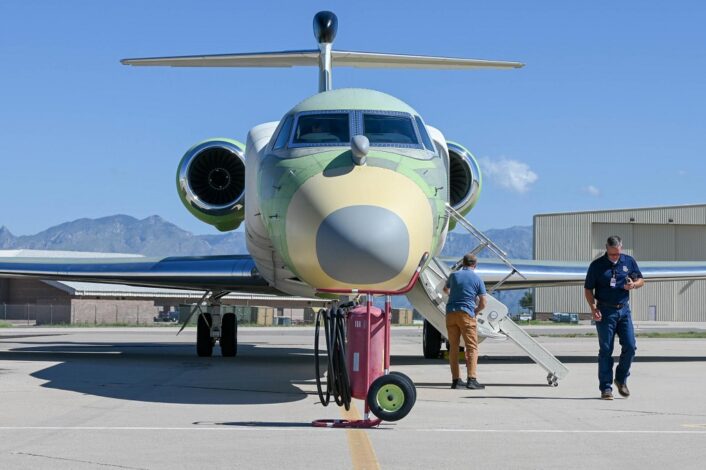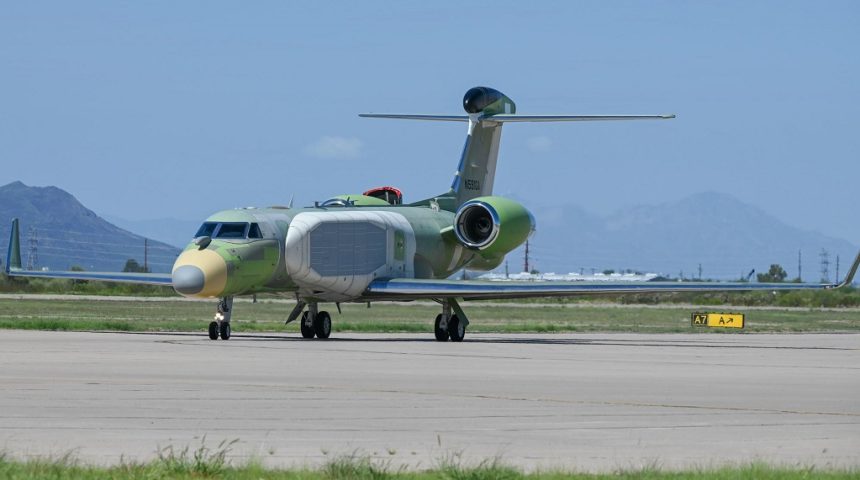The aircraft, slated to replace the EC-130H Compass Call, made a brief visit to show to the 55th Electronic Combat Group the progress with the program.
The U.S. Air Force released new photos of the new EC-37B Compass Call as it briefly visited Davis-Monthan Air Force Base on August 17, 2022. The visit gave to the personnel of the 55th Electronic Combat Group the opportunity to see up-close the aircraft that will replace in a few years their ageing EC-130Hs giving in turn better performance and new capabilities over the retiring aircraft. The aircraft, which received all external modification, is still flying with its primer paint and the civilian registration N591GA.
As you may know already, the Compass Call system is an airborne tactical electronic attack weapon system installed on a heavily modified version of the C-130 Hercules, called EC-130H Compass Call. This system disrupts enemy command and control communications, radars, and navigation systems and limits adversary coordination, which is essential for enemy force management.
The EC-130H flew for the first time in 1981 and was delivered to the Air Force a year later. The Compass Call is one of the busiest assets of the entire US inventory, which took part in every conflict where US troops were engaged in combat, and is also longest continuously deployed Air Force asset, being deployed since 2002 in Afghanistan. After 40 years, however, the EC-130H is in need of a replacement, with five aircraft out of 14 already retired.
Following the type’s retirement announced in 2014, the U.S. Air Force initiated the Compass Call Rehost program, which will move the current Compass Call systems from the EC-130H to the new EC-37B, based on the Gulfstream G550 Conformal Airborne Early Warning Aircraft (CAEW) airframe. As for the EC-130H, BAE Systems is the contractor for the Prime Mission Equipment (PME) and L3 Communications is the contractor for aircraft integration and depot maintenance.
The selection of the G550 was the conclusion of a series of assessments that led the Air Force to choose to rehost the existing Compass Call mission system onto a commercial derivative aircraft, resulting in a sole-source contract to L3 Communications and Gulfstream in 2017. The G550 has increased speed, endurance, and extended stand-off range over the legacy EC-130H aircraft, says L3Harris, providing significantly improved survivability, as well as providing improved stand-off jamming capability and flexibility to counter sophisticated communications and radar threats.

Ten EC-37Bs, the first three of which are currently being modified in Savannah, Georgia, and Waco, Texas, are scheduled to replace the entire EC-130H fleet. It seems, however, that the order might be increased to 14 aircraft, replacing the EC-130H in a 1-to-1 ratio. The first flight of the new EC-37B took place on October 7, 2021, while the first ground test of the fully modified aircraft equipped with the Compass Call system are planned for 2023. Air Combat Command plans to field the first five EC-37Bs in 2023.
These first five EC-37B aircraft will host the current Baseline 3 variant of Compass Call, which will be “transplanted” from the retired EC-130Hs. The remaining aircraft are scheduled to receive the upgraded Baseline 4 variant currently in development, which will reportedly introduce a new low-band jammer system.
One of the technologies that should make it into the Baseline 4 system is the Small Adaptive Bank of Electronic Resources (SABER) technology by BAE Systems, which was successfully flight tested for the first time last year. According to the statement from BAE Systems, SABER is a major technological advance that will allow the Compass Call weapon system to transition from hardware to software-based electromagnetic spectrum (EMS) warfare capability.
The SABER system is built on a suite of Software Defined Radios (SDRs) using an open system architecture and will provide the backbone of the new EC-37B’s operating system. This way, the Compass Call can be updated without significant physical reconfiguration and enable the U.S. Air Force to rapidly and proactively respond to emerging enemy threat systems.









